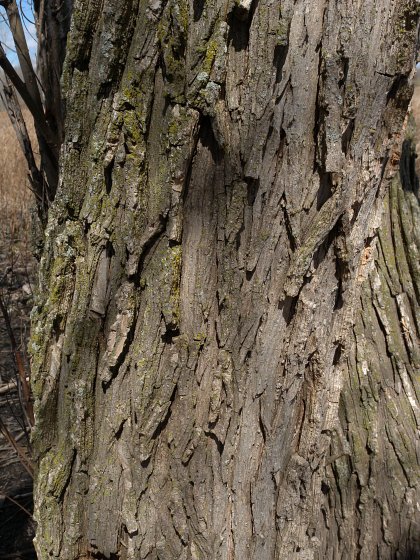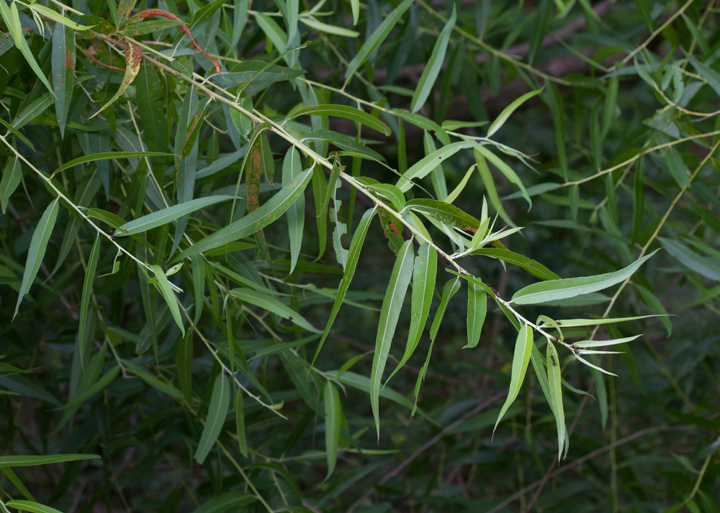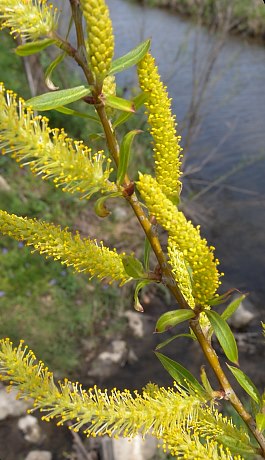Black Willow
Salix nigra Marshall
Description
Black willow is a member of the willow family (Salicaceae). It has numerous local names including American willow, gulf black willow, Champlain willow and puzzle willow ¹. Black willow is a deciduous, fast-growing, small to medium-sized tree that grows about 30 to 90 feet high and may have multiple trunks1,2. It is a relatively short-lived tree ². Black willow often grows in moist or wet soils due to their shallow or superficial root system 2,4. It has simple, alternate, 3 to 5-inch leaves that are very narrow, with finely serrate margins and are pointed at the tip 2,4. Male and female flowers are on separate trees (dioecious) and form catkins¹. Both catkins are 1 to 3 inches in length and are without petals. The male catkins are yellow while the female are green ². Male catkins are pollinated by insects or possible wind. The female catkins produce capsules that release tiny seeds covered with cottony hairs to aid in wind dispersal in mid-summer ².

Bark of mature black locust, Illinois Wildflowers ²

Leaves of black willow. @ B. Hubick*, Maryland Biodiversity Project 7

Male catkins of black willow. Illinois Wildflowers ²
Female capsules releasing seed. J. Solem, Maryland Biodiversity Project 7
Distribution
Black willow is a North American species that extends from New Brunswick, Canada to Minnesota, south to Texas and east to the Florida panhandle 11. Distribution in the west may result from introductions, and some consider the California specimens to be either a subspecies or a separate species, Salix gooddingii 11. Black willows are the most common willow in Maryland and are found in every county in the state ⁷. This tree is often found on the banks of streams or lakes, where their preferred soil type is most common¹.

North American distribution of black willow 8
Wildlife Importance
The black willow is integral to the wildlife within its native range. The tree is mildly tolerant of grazing. Birds often eat the catkins. Other animals like rodents eat the bark, and deer graze on the leaves⁷. Black willow’s bark, twigs, and buds also serve as a winter food source for mammals such as deer, rabbits, and beavers 9. The black willow is one of the first plants in the spring that honeybees use for nectar and pollen ¹. There is a specific clade of bees that only collect their pollen from willow trees ⁷. It serves as a larval host for Mourning Cloak, Viceroy, Red-spotted Purple, Viceroy and Tiger Swallowtail butterflies 9. Due to the shallow root system, the black willow is excellent for stabilizing and binding the soil so is an exceptional plant to use for erosion control ².
Economic Importance
The black willow has soft flexible wood that makes it valuable for commercial use¹. Black willow is used primarily for crates, barn floors, and wooden toys¹. Its wood does not splinter often, has high shock resistance, and can hold its shape even with moderate impact⁷. Therapeutic teas can be made from black willow bark to treat joint pains¹. Salicylic acid can also be isolated from the inner bark and is used as a pain and fever reducer similar to modern aspirin, which is a synthetic form of Salicylic acid ¹. Black willows bind soil banks and prevents erosion and flood damage, thus making them a popular landscape plant in parks and wet regions 9.
Threats
There are only a small number of insects that cause damage to the black willow tree. The forest tent caterpillar, cottonwood leaf beetle, and willow sawfly can cause long-term harm to the tree. This species is also susceptible to a few diseases like powdery mildew, which is a fungal disease that occurs in dry and warm climates². Black willow is also impacted by crown gall, which is a bacterial disease that infects roots and branches and causes them to swell ¹.
Interesting Facts
- The bark willow was used to make tea in ancient Greece. The bark contains a chemical, called salicin that can reduce pain and fever1,5.
- The flexible and soft properties of the black willow wood is why at one point it was used to make prosthetic limbs ⁸.
- The common name black willow comes from the dark brown or black bark².
- The wide spread roots of the black willow can sewer or water lines².
References
- USDA NRCS Plant Fact Sheet: Black willow
- Illinois Wildflowers: Black willow
- Wildflowers and Weeds: Salicaceae
- North Carolina State Extension: Salix nigra
- Nebraska Forest Service: Willow, black
- Minnesota Wildflowers: Salix nigra
- Maryland Biodiversity Project: Black willow
- Virginia Tech Dendrochronology: Black willow
- Lady Bird Johnson Wildflower Center: Salix nigra
- Fire Effects Information System: Salix nigra
- USDA Forest Service Silvics, Vol. 2, Hardwoods: Salix nigra
* Imaged used with permission of photographer.
Contributed by K. Schirel and K. Wolferman

